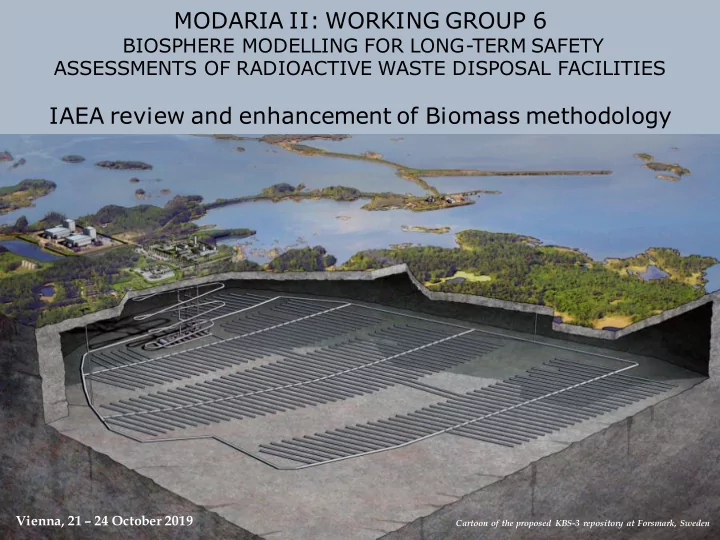

MODARIA II: WORKING GROUP 6 BIOSPHERE MODELLING FOR LONG-TERM SAFETY ASSESSMENTS OF RADIOACTIVE WASTE DISPOSAL FACILITIES IAEA review and enhancement of Biomass methodology Vienna, 21 – 24 October 2019 Cartoon of the proposed KBS-3 repository at Forsmark, Sweden
MODARIA II: WORKING GROUP 6 BIOSPHERE MODELLING FOR LONG-TERM SAFETY ASSESSMENTS OF RADIOACTIVE WASTE DISPOSAL FACILITIES IAEA review and enhancement of Biomass methodology Outline Background • Key enhancement areas • Current status of enhanced report • Vienna, 21 – 24 October 2019 Cartoon of the proposed KBS-3 repository at Forsmark, Sweden
BIOMASS Background • BIOMOVS II (1991-1996) – Developed “ Reference Biospheres Methodology ” – International “ Reference ” models inappropriate – Instead: methodology and FEP list to encourage transparency, consensus and harmonisation • IAEA BIOMASS (1996-2001) – Theme 1 further developed and refined the methodology – Acknowledged there was further work to do
BIOMASS Background • BIOMASS methodology has proved very useful – Highlights systematic and transparent approach – Providing guidance that is adapted to each case • Wealth of experience in intervening time – Further international collaborations – Experience from examples of practical application – Developments in context of assessments – Scientific developments
WG6 Meetings • Meetings: – 20-22 April 2016, Brussels – 31 October-3 November 2016, Vienna – 10-12 May 2017, Brugg – 30 October – 3 November 2017, Vienna – 16-18 May 2018, Kerava – 22-25 October 2018, Vienna – 15-17 May 2019, Munich – 21-24 October 2019, Vienna • Field trip to periglacial analogue • Extensive collaborative work – Close to 80 participants – Over 100 presentations – Close to 300 pages of workshop reports
Contributors and Organisations • BIOPROTA project – Progress only possible with support of the sponsors of the BIOPROTA project • ANDRA, BfS, DSA, ENSI, FANC, LLWR, Nagra, NUMO, NWMO, Posiva, RWM, SKB, SSM – BIOPROTA Technical Support Team • Support to facilitation and reporting of workshops • Support drafting of updated guidance
Original BIOMASS Methodology A. Setting down the assessment context Output: The underlying premises of the calculation (what is being calculated and why) are stated explicitly. B. Identification and justification of biosphere system(s) Output: Biosphere system, or a series of biosphere systems, identified by the principal component types, e.g. climate, topography etc. Principles for identification of biosphere systems C. Biosphere system description FEP list and Outputs: A word picture that provides qualitative and, where screening appropriate, quantitative description of the biosphere system. A description of potential exposure pathways. D. Consideration of potentially exposed groups Outputs: A list of candidate critical groups and/or other groups of Principles for critical special interest, where appropriate. Fully characterised exposure group selection groups. E. Model development Data selection Output: Assessment model. principles F. Calculation Output: Doses or concentrations as required by the assessment context.
Refinements Identified Climate Assessment Context development & downscaling Biosphere system identification FEP list and and justification Geosphere screening (discharge locations) Site under- Biosphere system descriptions Near-surface standing Human actions, wildlife investigation methods and Potentially exposed group experience Data and definition human PEGs and model Landscape wildlife PEPs development selection Biosphere and supporting model principles Principles for critical definition group selection Conceptual model, mathematical Protection of the model & data environment Calculation & communication Confidence building
Enhanced Methodology • Recognise importance of methodology diagram • Want to emphasise importance of – Site understanding: “ Let the site tell the story ” – Integration with overall safety assessment and safety case – Degree of iteration and interaction
Report Structure
Key enhancement areas
Integration with Safety Case
Integration with Safety Case
Biosphere Narrative v Description
Biosphere Narrative v Description • Clarification of narrative versus description of the biosphere • Bridges gap with MODARIA I WG6 • Climate dynamics over the next few thousand years proposed for MODARIA III
Use of Site Information
Use of Site Information • Site information collected for many purposes – Site characterisationis required for facility design, operational impact assessment, environmental impact assessment and post-closure safety assessment. – Highlights the importance of the dialogue between biosphere assessment and system understanding
Biosphere System • Deciding how to represent the biosphere in assessments
PEGs and PEPs • Guidance on Potential Exposure Groups – Characteristics – Behaviour • Guidance on Biota Potentially Exposed Populations – Selection principles – Representation in a spatial context
Information Boxes • Used to provide more detailed guidance on particular topics
Data Selection Principles • Only minor changes
System Understanding • Various approaches • Interaction matrices for system understanding and conceptual model development
Conceptual and Mathematical Models
Conceptual and Mathematical Models
Mathematical Representation • Increased transparency of mapping conceptual to mathematical model
Current status and plan to print • Completed report – Concise methodology ready – Final draft in IAEA template ready – Final review and approval until mid November – IAEA review and printing 2020 (?) • Supplementary information under development – BIOPROTA report 2020 • So, its too late to join us! … but maybe during next Programme?
Po tential papers from Working Group 6 • IAEA guidance on climate and landscape change as an input to defining biosphere characteristics for post-closure biosphere assessments of repositories for radioactive wastes (Paper) • Approaches to the definition of potentially exposed groups and potentially exposed populations of biota in the context of solid radioactive waste disposal (Paper) • The updated BIOMASS methodology as illustrated by approaches adopted in various assessments (Review) • A roadmap of research and development requirements to support applications of the updated BIOMASS methodology (Paper/Opinion)
MODARIA II: WORKING GROUP 6 BIOSPHERE MODELLING FOR LONG-TERM SAFETY ASSESSMENTS OF RADIOACTIVE WASTE DISPOSAL FACILITIES IAEA review and enhancement of Biomass methodology Thank you! Vienna, 21 – 24 October 2019 Cartoon of the proposed KBS-3 repository at Forsmark, Sweden
Recommend
More recommend